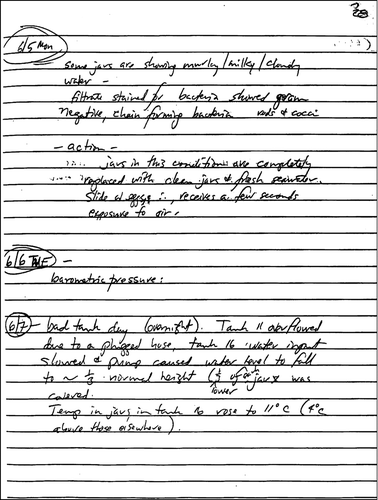Figures & data
Figure 1 Experimental set-up for the oiled-gravel exposure experiments with salmon embryos (Heintz et al. Citation1999) and herring embryos (Carls et al. Citation1999, Citation2005). The column dimensions for the salmon study were 60 cm × 15 cm diameter and were 122 × 30 cm diameter for the herring study.
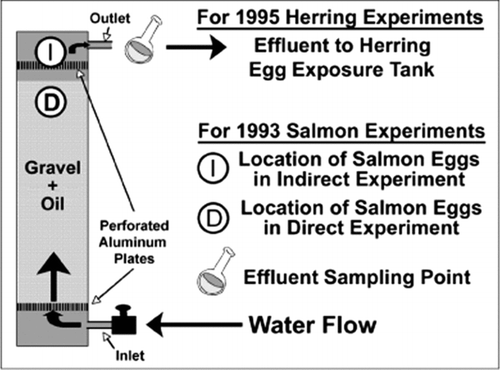
Table 1 Exposure conditions for oiled-gravel column exposure experiments with salmon and herring eggs and larvae. Column size was 60 cm long × 15 cm diameter for the salmon studies and 122 cm long × 30 cm diameter for the herring experiments.
Table 2 TPAH concentrations in gravel, water, and egg tissues, and egg/fry mortality in different treatments for the salmon study (Heintz et al. Citation1995, Citation1999; EVOSTC 2009). Tissue TPAH values are rounded to the nearest 10 μg/kg dry wt. Results reported as significantly different (p = .05) from control are identified in boldface and with an asterisk.
Figure 2 Egg tissue PAH concentrations from Heintz et al. (Citation1999) for the salmon egg/larvae VWO treatment producing toxic responses and the AWO treatments producing no toxic responses.
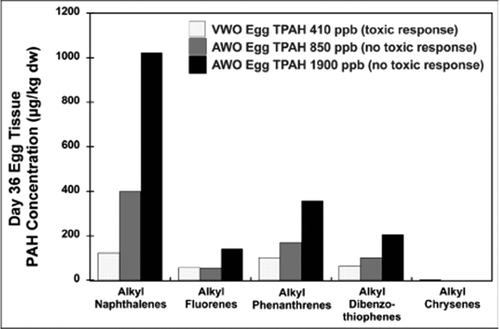
Figure 3 Salmon egg mortality versus dose for five dose metrics. A. Salmon egg mortality compared to the concentration of oil on gravel from Heintz et al. (Citation1999), used with permission; B. and C. Salmon egg mortality compared to aqueous concentrations of TPAH or alkyl-phenanthrenes; D. and E. Salmon egg mortality compared to tissue concentrations of TPAH or alkylphenanthrenes.
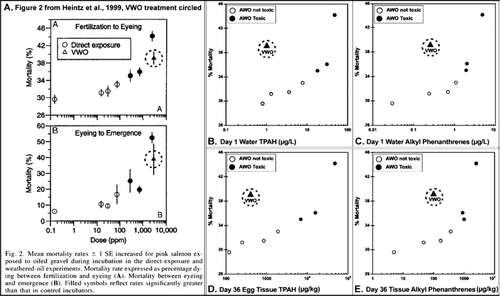
Figure 4 Comparison of non-toxic AWO and toxic VWO aqueous exposure concentrations of alkyl-phenanthrenes in salmon egg exposures (Heintz et al. Citation1995, Citation1999; EVOSTC 2009). Data are fit using simple exponential decay curves.

Figure 5 Re-drawn from Heintz et al. (Citation1995) with additional descriptive information from Heintz et al. (Citation1999) and EVOSTC (2009) and .
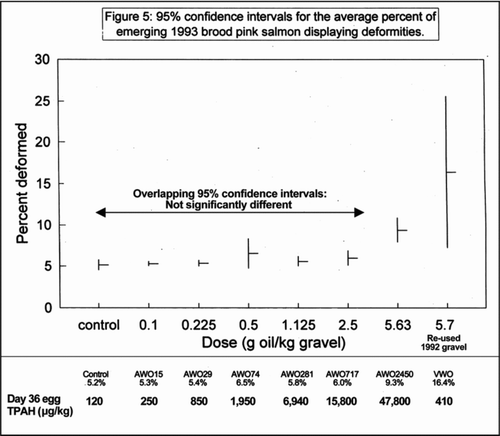
Table 3 Key results of the 1999 Carls salmon study (Carls et al. Citation2003) and the 1993 Heintz salmon study (Heintz et al. Citation1999). Treatments are arranged in terms of increasing initial water TPAH concentration.
Table 4 Oil loading (mg/kg total extractable organics) on column gravel at day 0 and PAH concentrations on column gravel on day 2 of the herring eggs study (Carls et al. Citation1997, Citation1999).
Figure 6 Bioconcentration curve of TPAH in herring eggs during exposure of the middle treatment concentration of MWO effluent. Maximum dry weight tissue TPAH concentration occurred at day 4 of exposure. From Carls et al. (Citation1999) and summarized in EVOSTC (2009).
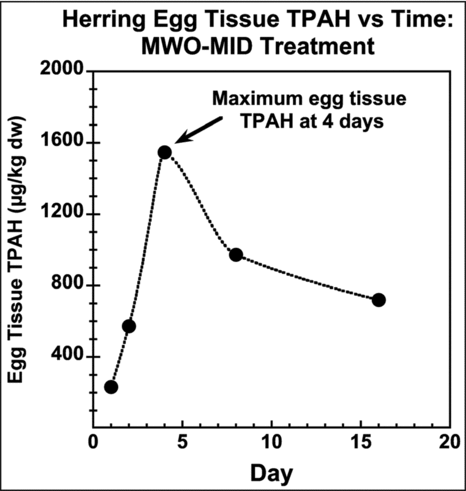
Figure 7 Aqueous concentrations of different alkyl-PAH congener groups at day 4 and 8 of exposure of herring eggs to the middle MWO treatment and the low LWO treatment in relation to larvae mortality. Data show that mortality in the MWO treatment occurred at lower aqueous alkyl-PAH concentrations than occurred in the non-toxic LWO treatment. Data from Carls et al. (Citation1999) and EVOSTC (2009).
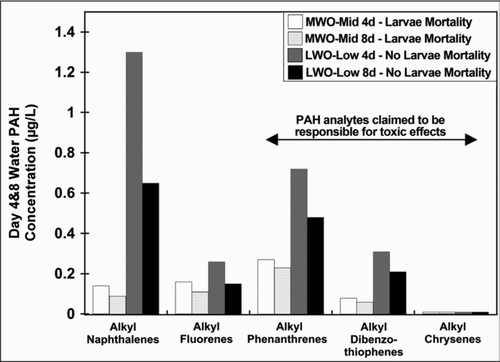
Figure 8 Frequency of sublethal effects in herring larvae versus aqueous TPAH and aqueous alkyl-PAH congener concentrations. A. Frequency of significant sublethal effects in herring larvae exposed to different aqueous TPAH concentrations in LWO and MWO effluents. B. Aqueous concentrations of different alkyl-PAH congener groups in non-toxic trace LWO and toxic low MWO effluents. Frequency of yolk sac edema was significantly increased in herring larvae exposed to low MWO effluent. Data from Carls et al. (1997, 1999) and EVOSTC (2009).
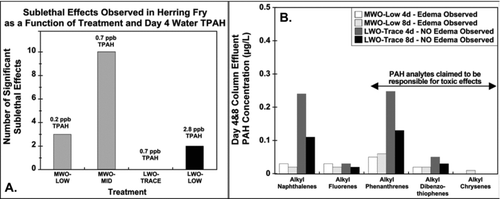
Figure 9 Relationship between initial aqueous TPAH concentrations and% mortality of herring eggs during exposure to LWO (squares) and MWO (circles) effluents. Filled symbols represent values significantly difference from controls. Figure from Carls et al. (Citation1999), used with permission.
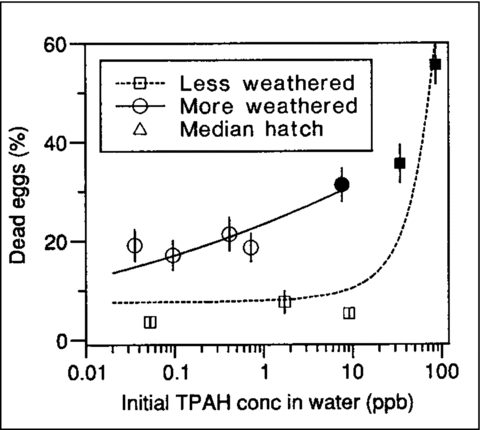
Table 5 Day 0 (initial) concentrations of TPAH and individual alkyl-PAH congener groups in column effluent water (EVOSTC 2009) and response data for the LWO-Low concentration treatment and the MWO-High and MWO-Mid concentration treatments of the herring egg studies (Carls et al. Citation1997, Citation1999).
Figure 10 Ratios of C18 versus sum of chrysenes (an indicator of biodegradation) with time in effluent water from the high-concnetration LWO and MWO treatments in the herring egg studies of Carls et al. (1997, 1999). Chemistry data are from (EVOSTC 2009).
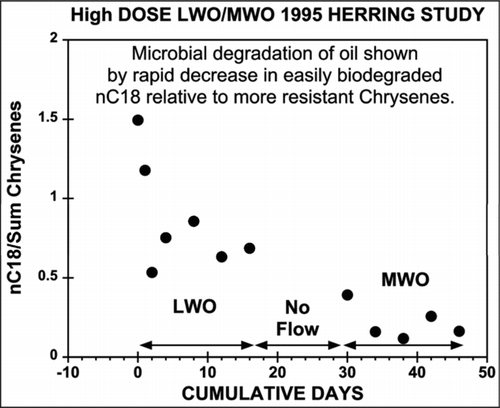
Appendix 1 NOAA FOIA 2010-0138 material (Sebastian Citation2010) showing that data were taken for a very weathered oil (VWO) treatment in the Carls et al. (Citation1999) salmon study. The FOIA file “Blue notebook PWS-344.pdf,” p. 55, shows the workup of embryo survival at eyeing data. This notebook entry shows that VWO treatment response measures were assessed on a date not given, but between 11/13/99 and 12/9/99. The VWO mean (Level 1) and the control mean Level 0) are almost identical. The inset shows data from FOIA 2010-0138 file “mass.pdf,” for weights at emergence (∼180 days) that were measured for the VWO treatment and control treatment emergent fry. The control mean is 0.201 ± 0.027 g and the VWO mean is 0.207 ± 0.021 g.
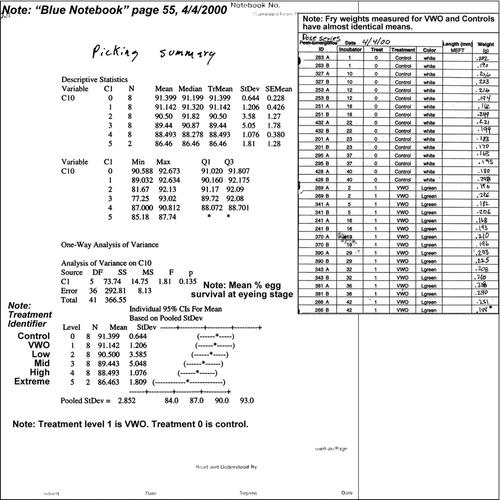
Appendix 2 Heintz 1993 Pink Salmon Genetics Lab Notebook (Dahlberg Citation1998), p. 35, October 24, 1993 recorded observations of eggs with oil particles on surface.
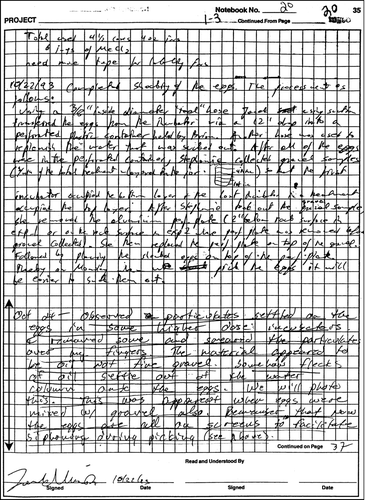
Appendix 3 Heintz laboratory record: ‘93 BY Incubation-Env Monitor, December 5, 1993–December 17, 1993 (Dahlberg Citation1998). Note clear evidence of non-dissolved oil on eggs and also white fungus noted for all treatments.
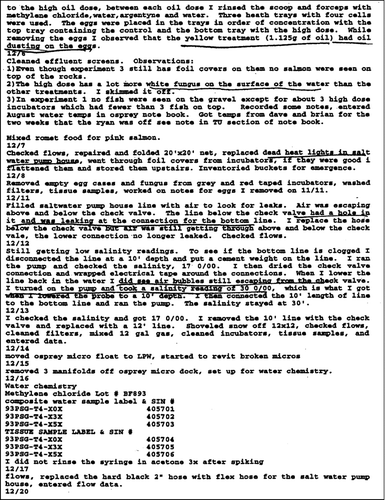
Appendix 4 Carls Herring Study notebook June 5, 1995, p. 28 (Dahlberg Citation1998) recorded observations of bacterial growth and problems with flow system. The levels of bacterial contamination, as evidenced by cloudy water and gram negative bacteria, illustrate potentially significant effects on herring embryos/larvae from microbial contamination.
